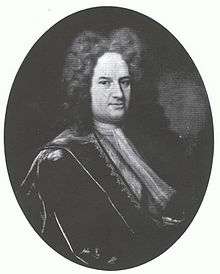Earl Stanhope
Earl Stanhope (pronounced Stannup[1]) was a title in the Peerage of Great Britain. It was created in 1718 for James Stanhope, 1st Viscount Stanhope, the principal minister of King George I, with remainder to the heirs male of his body. Stanhope was the son of the Hon. Alexander Stanhope, fifth and youngest son of Philip Stanhope, 1st Earl of Chesterfield. He had already been created Viscount Stanhope, of Mahón in the Island of Minorca, and Baron Stanhope, of Elvaston in the County of Derby, in 1717, with remainder, failing heirs male of his body, to his second cousin John Stanhope of Elvaston (who was the father of William Stanhope, 1st Earl of Harrington) and the heirs male of his body. These titles were also in the Peerage of Great Britain.
Lord Stanhope's grandson, the third Earl, was a politician and scientist, known as "Citizen Stanhope" because of his sympathy for the French revolution. He was succeeded by his son, the fourth Earl. He represented several constituencies in the House of Commons but is chiefly remembered for his involvement in the Kaspar Hauser case. His son, the fifth Earl, was a Tory politician and historian. He served as Parliamentary Under-Secretary of State for Foreign Affairs and also published a biography on William Pitt the Younger. On his death the titles passed to his son, the sixth Earl. He was a Conservative politician and served briefly as a Lord of the Treasury from 1874 to 1875 in Benjamin Disraeli's second administration. Lord Stanhope was also Lord Lieutenant of Kent.
His son, the seventh Earl, was also a Conservative politician and notably served as President of the Board of Education, as Leader of the House of Lords and as First Lord of the Admiralty. In 1952 Lord Stanhope succeeded his distant relative Edward Henry Scudamore-Stanhope, 12th Earl of Chesterfield, as thirteenth Earl of Chesterfield and 13th Baron Stanhope. However, he never applied for a writ of summons to the House of Lords in these titles and continued to be known as the Earl Stanhope. On his death in 1967 the earldoms of Stanhope and Chesterfield and barony of Stanhope became extinct. However, he was succeeded in the viscountcy of Stanhope of Mahon and barony of Stanhope of Elvaston according to the special remainder by his kinsman William Stanhope, 11th Earl of Harrington.
The heir apparent to the Earls Stanhope used the courtesy title Viscount Mahon.
Philip Stanhope, 1st Baron Weardale, was a younger son of the fifth Earl.
Viscounts Stanhope, of Mahon (1717)
- James Stanhope, 1st Viscount Stanhope (1673–1721)
Earls Stanhope (1718)
- James Stanhope, 1st Earl Stanhope, 1st Viscount Stanhope (1673–1721)
- Philip Stanhope, 2nd Earl Stanhope (1714–1786)
- Philip Stanhope, Viscount Mahon (1746–1763)
- Charles Stanhope, 3rd Earl Stanhope (1753–1816)
- Philip Henry Stanhope, 4th Earl Stanhope (1781–1855)
- Philip Henry Stanhope, 5th Earl Stanhope (1805–1875)
- Arthur Philip Stanhope, 6th Earl Stanhope (1838–1905)
- James Richard Stanhope, 13th Earl of Chesterfield, 7th Earl Stanhope (1880–1967)
Viscount Stanhope, of Mahon (continuation)
Following the death of the 7th Earl Stanhope, and the extinction of that title, the titles Viscount Stanhope of Mahon and Baron Stanhope of Elvaston passed to his distant relation, William Stanhope, 11th Earl of Harrington.
- William Henry Leicester Stanhope, 11th Earl of Harrington, 8th Viscount Stanhope of Mahon (1922–2009)
- Charles Henry Leicester Stanhope, 12th Earl of Harrington, 9th Viscount Stanhope of Mahon (b. 1945) (Son of the 11th Earl)
The heir apparent is the present holder's son William Henry Leicester Stanhope, Viscount Petersham (b. 1967).
The heir apparent's heir apparent is his son the Hon. Augustus Stanhope (b. 2005).
See also
Notes
- ↑ Debrett's Correct Form, Debrett's Peerage Ltd, 1976, pg 408
References
- Kidd, Charles, Williamson, David (editors). Debrett's Peerage and Baronetage (1990 edition). New York: St Martin's Press, 1990,
- Leigh Rayment's Peerage Pages
- Lundy, Darryl. "FAQ". The Peerage.
